If generative AI is innovative for enterprises in 2023, being cloud-based is ubiquitous. What that means is that the data today is extremely voluminous and complex. Not to mention that all that data needs proactive monitoring and analysis.
That being said, data in observability and monitoring can often be complex and challenging to understand due to its sheer volume and diversity. Here’s a list of types of data that are quite complex to understand:
- Log Files
- Network Traffic Data
- Server Metrics
- Application Performance Metrics
- Security Logs
- Container and Orchestration Data
- User Activity Logs
- IoT Device Data
- Cloud Service Metrics
So no wonder the demand for observability platforms is at an all-time high. However, the statistics from several surveys show that only a small percentage of organizations have complete observability across their environment.
It is becoming more challenging for engineers and IT teams to deal with the increasing complexity of data. Enter generative AI, leveraging the burden of repetitive and contextual analysis ever-so efficiently.
In this blog, we will explore how generative AI will bridge the knowledge gaps within data observability and introduce the benefits of Apica’s generative AI assistant.
Unveiling Apica’s Generative AI Assistant
According to Gartner, nearly 40% of enterprise applications are projected to integrate conversational AI by 2024.
While both conversational and generational AI serve different purposes and unique functions, they frequently share common ground. For instance, a conversational AI such as ChatGPT utilizes generative AI methods to generate its conversational responses.
At Apica, we have been discussing how generative AI will contextualize the observability landscape. You see if most fields out there can be impacted by it, then why not data observability?
Today, we are thrilled to announce that the Apica Ascent Platform is now integrated with a generative AI assistant. This integration is a hallmark in the series of innovative strides in Apica’s mission to empower users with tools that not only enhance productivity but also reduce the toil associated with data analysis.
The key highlights of the integration include:
1. Built-in Generative AI Assistant: With this integration, Apica Ascent users will have access to a powerful AI assistant that simplifies complex tasks, automates data analysis, and provides valuable insights. This assistant is ready to take productivity to new heights.
2. Support for Leading AI Models: Apica Ascent offers support for the industry-leading AI models, including OpenAI’s ChatGPT and Azure OpenAI. Users can harness the capabilities of popular models like GPT-4, GPT-3.5-Turbo, or even leverage custom models trained on proprietary datasets.
3. Enhanced Contextual Insights: Apica’s Generative AI Assistant is strategically designed to reduce friction in the last mile of data analysis. It adds context to the data being analyzed, making it easier for users to derive meaningful insights quickly.
Benefits of Apica’s Generative AI Integration
Though this is only the first phase in our strategy to implement generational AI across the Apica platform, the generative AI Assistant is set to realign how enterprises interact with their data.
The new feature, including ChatGPT and Azure OpenAI service, integrates into the Explore feature. Now, you can easily select logs and engage in dynamic conversations with Generative AI to gain in-depth insights into your log data.
It allows you to ask questions, request explanations, and explore your logs to gain deeper insights into your log data, making log analysis more informative and versatile.
With that being said, Enterprises using the Apica Ascent platform can now unlock the full potential of their data, streamline their workflows, and boost overall productivity.
Following are the many benefits that the generative AI feature offers:
– Enhanced Log Analysis: Apica’s AI assistant integration streamlines log analysis by automatically parsing and extracting key insights from log data, saving valuable time and effort.
– Contextualization of Data: The AI assistant adds context to log entries, making it easier to understand the significance of each event and its impact on system performance.
– Faster Problem Resolution: With contextualized log data, troubleshooting and problem resolution become more efficient, leading to reduced downtime and improved system reliability.
– Improved Decision-Making: Users can make informed decisions based on the contextualized log information, ensuring that critical issues are addressed promptly.
– Reduced Toil: The AI assistant minimizes the manual effort required for log analysis, reducing the burden on IT teams and allowing them to focus on higher-value tasks.
– Customizable Insights: Users can tailor the AI assistant to generate specific insights and alerts based on their unique requirements and thresholds.
Note: In the current release, the AI assistant gets insights only from the log lines, and it will also help users troubleshoot problems based on the log lines. However, in the upcoming releases, the feature will be extended for alerts as well.
– Scalability: The integration scales effortlessly with growing log data volumes, ensuring that it remains effective in handling increasing workloads.
– Compliance and Security: Contextualized log data aids in compliance audits and enhances security monitoring by providing a comprehensive view of system activities.
– User-Friendly Interface: The AI assistant’s intuitive interface makes log analysis accessible to users with varying levels of technical expertise.
How Generative AI Bridges Knowledge Gaps
Generative AI is more than just a novelty; it’s a powerful tool that empowers users to harness the full potential of data. It enhances data analysis, closes knowledge gaps, and drives better outcomes in the following ways:
- Contextualization of Data: Generative AI excels at adding context to data, making it more understandable and relevant. It interprets the significance of data points, a task often challenging for humans when dealing with raw information.
- Turning Data into Action: Raw data rarely provides clear guidance on what actions to take. Generative AI fills this gap by generating actionable insights. It identifies patterns, & anomalies, and recommends steps to address issues or capitalize on opportunities.
- Efficiency and Time Savings: Manual data analysis can be time-consuming. Generative AI automates this process, saving time and effort. It quickly processes data, extracts valuable information, and presents it in an understandable format.
- Enhancing Decision-Making: By providing context and actionable insights, generative AI aids in informed decision-making. Users can rely on AI recommendations to make choices based on a deeper understanding of the data.
Generative AI serves as a knowledge multiplier, filling gaps in understanding or expertise. It ensures that users, regardless of their expertise level, can make sense of complex data.
Addressing Unique Requirements and Challenges
As the appetite for Generative AI is growing, users are seeking ways to make AI an integral part of their work beyond novelty. Apica Ascent Generative AI Assistant addresses this need by providing the missing link in data analysis – context. It bridges the gap between raw data and actionable insights, saving valuable time and effort.
Alternatives and the Apica Advantage
Before the introduction of Generative AI tools, users often resorted to time-consuming and inefficient methods to gather context for their data analysis. This involved navigating between various data platforms and search engines to find relevant information, resulting in wasted time and potential errors.
Apica’s solution eliminates these challenges by offering a seamless experience within the Apica Ascent platform. Users can now access AI-generated context and insights directly, eliminating the need for manual, error-prone searches.
The AI assistant can be used to address unique requirements and challenges, such as:
- Identify patterns and trends in log data that would be difficult to detect manually.
- Generate custom reports and alerts based on specific criteria.
- Automate the process of troubleshooting and problem resolution.
- Provide contextual insights to help users make better decisions.
A First in Data Fabric
What sets Apica apart from the competition is its status as the first data fabric to offer a Generative AI assistant. While still in its nascent stage, this feature reinforces Apica’s commitment to innovation and staying at the forefront of technology trends.
In conclusion, Apica’s integration of the Generative AI Assistant into the Apica Ascent platform represents a significant leap forward in data analysis and productivity enhancement. With the power of AI at their fingertips, Apica users can expect to streamline their workflows, gain deeper insights, and reduce manual toil – all within a single, integrated platform. As the leading data fabric platform to offer generational ai capabilities for logs, Apica continues to lead the way in harnessing the potential of Generative AI for enterprises.















